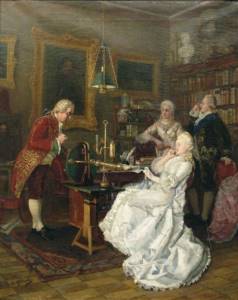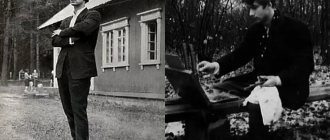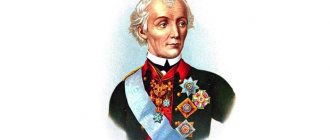Mikhail Vasilyevich Lomonosov is a famous Russian natural scientist, chemist, physicist, he laid the foundations of Russian science, the modern Russian language, and the educational system. He was born in 1711 in the Arkhangelsk province, in the village of Mishaninskaya (currently the village of Lomonosovo). In addition to his extensive scientific activities, he created a project at Moscow University, which was named after him. The descendants of Mikhail Vasilyevich Lomonosov represent various Russian classes. These included aristocrats, serving nobility, clergy, peasants and commoners.
Family
M.V. Lomonosov studied abroad for five years. He was sent to Europe as part of a group of 12 of the most talented young men from the Spassky Schools. In Germany, at the University of Marburg, he studied for three years. He lived in the house of the widow of a German brewer, Catherine-Elizabeth Zilch, whose daughter, Elizabeth-Christina, he married in February 1739. Later, on May 26, 1740, the wedding took place in the Reformed church. On December 22, 1741, Lomonosov had a son, Ivan, who died in January 1742. Lomonosov’s first daughter died in 1743.
After the whole family moved to St. Petersburg, on February 21, 1749, another daughter, Elena, was born. This is the only surviving child of the great scientist. The family took good care of the sweet and smart girl, who promised to turn into a young beauty with age. And Mikhail Vasilyevich had unquestioning authority and respect from his daughter and wife. Both treated him with great respect.
Women of Lomonosov
For the first nine years, young Mikhail was raised by his mother, the daughter of Deacon Ioann Sivkov from the surrounding village of Matigory. He was the first (and only) child; his parents got married exactly a year before his birth. Since the head of the family, Vasily Dorofeevich, regularly went fishing at sea, most of the time the boy was raised by his mother. It is known that Elena Lomonosova, unlike her husband, was literate. But it is unlikely that she had time to teach her son to read and write: the boy mastered this art with the help of his neighbor Ivan Afanasyevich Shubny.
The mother died when the boy was eight or nine years old. And a year later, the father married a second time: the house could not stay in the north without a woman. Lomonosov's stepmother was the peasant's daughter Fedora Mikhailovna Uzkaya (or Uskova). She did not play a noticeable role in his fate, because she died soon, in 1724.
But the second stepmother, the daughter of a monastery peasant Irina Semyonovna Korelskaya, whom Vasily Dorofeevich married for the third time, left a noticeable imprint on Lomonosov’s life. She was an intelligent and powerful woman and had a great influence on her father. From the very beginning, the stepmother disliked her stepson. She was disgusted that Mikhailo, instead of helping his father with housework, read books. “I grew up... having... an angry and envious stepmother, who tried in every possible way to create anger in my father, imagining that I was sitting empty-handed reading books,” Lomonosov wrote many years later in a letter to Ivan Ivanovich Shuvalov on May 31, 1753.
To minimize domestic conflicts, the father began to take his son with him on fishing trips, and when Mikhailo reached adulthood, he decided to marry him to the daughter of a “mean man” in Kola. You can imagine the chagrin of the young man: he strives for knowledge and suffers for this misunderstanding of his father and persecution from his stepmother, and now he will have to go to the ends of the world, beyond the Arctic Circle, become the head of the family and support his wife and future children by fishing - where is there? studies!
It is likely that the role of these two women - the stepmother and the bride unknown to Lomonosov - pushed him to a desperate decision. He “feigned illness to himself, and therefore it was not done.” And so that his father would not find him another life partner, so as not to endure the reproach of his stepmother, he ran away from home to Moscow. One might say that, in contrast to the future hero of Fonvizin’s play, Mitrofanushka, Lomonosov implemented the motto: “I don’t want to get married, but I want to study!”
Irina Semyonovna Lomonosova died in 1732, shortly after the birth of her daughter Maria, whom her half-brother never saw: he never visited his homeland after leaving home in December 1730. Maria Vasilievna Golovina (c. 1732-1807) knew how to read and write and corresponded with her great brother. Lomonosov wrote the last letter in his life a month before his death to her. Maria's daughter Matryona Evseevna (1750-1830) lived in St. Petersburg, in Lomonosov's house on the Moika. “Despite her small years, she was in charge of the cellar, and therefore she had a lot of trouble and running around.” Shortly before her death, she managed to tell the writer P. P. Svinin many living stories about her uncle. Here is just one episode: “He often during lunch, instead of a feather, which, out of school habit, he liked to put behind his ear, he put a spoon with which he drank hot food, or wiped himself with his wig, which he took off when he started eating cabbage soup.”
|
| I. K. Fedorov. “Empress Catherine II with M. V. Lomonosov” |
But we went a little sideways. The main woman in Lomonosov's life was, of course, his wife, Elizaveta Christina Tsilkh (1720-1766), who, having converted to Orthodoxy, received the name Elizaveta Andreevna. They met in Marburg in November 1736, when Lomonosov, having arrived to study at the local university, stayed with the Tsilchs. Catherine's father Heinrich was a member of the Marburg City Council, a churchwarden in the Reformed Church, and a brewer by profession. He died shortly before his future son-in-law arrived in his house.
The Russian student began to court Elizabeth and probably spent significant sums of money on her that were given to him for his studies. These courtships were not in vain: on November 8, 1739, Elizabeth gave birth to a daughter, who at baptism received the name Catherine Elizabeth. Lomonosov was not around at that time: he left Marburg on business back in July and, barely returning to the Tsilchs, on May 26, 1740, married Elizabeth in the Reformed church.
In May 1741, Lomonosov returned to St. Petersburg. He ordered his wife, pregnant with their second child, not to write to him, but to wait for a call from him to Russia. For two years there was no word or breath from my husband. During this time, their son Ivan was born and died a month later. One can only guess how the poor young woman felt, who she considered herself to be: an abandoned wife, a widow? Without receiving any news from her husband, she decided to act on her own and in February 1743 she turned to the Russian ambassador in The Hague, Count A.G. Golovkin with a request to send a letter to his missing husband to St. Petersburg.
A month later, the letter found its addressee and caused a lot of noise: his colleagues at the Academy of Sciences considered Lomonosov a bachelor, he never mentioned his wife and children remaining in Germany. The official version explains this incomprehensible circumstance for two reasons. First, the marriage of a Russian student to a German woman during an internship was, in fact, prohibited: this required permission from the Academy of Sciences. And Lomonosov already had a lot of troubles during his years of study, and he didn’t want to add an unauthorized marriage to them. The second reason is that Lomonosov first wanted to arrange housing and earn enough money to later invite his family to join him.
According to the testimony of Professor Jacob Stehlin, who handed the letter from Marburg to the addressee, Lomonosov, having read it, exclaimed: “...My God! I have never left her and never will; Circumstances prevented me from writing to her, much less calling her to me. But let her come when she wants; I’ll send her a letter and 100 rubles of money tomorrow.”
This phrase is always quoted to justify Lomonosov. However, its meaning in the language of the 18th century was slightly different than it is now: the expression “when he wants” meant two and a half centuries ago “if he wants.” So let’s leave this strange family situation on the conscience of Mikhaila Vasilyevich.
In the summer of 1743, Elizabeth and her daughter arrived in St. Petersburg. Probably, their wedding soon took place in the Orthodox Church. Russian law allowed marriages with representatives of other Christian denominations, but it was required that children be raised in Orthodoxy.
From then until Lomonosov's death, more than twenty years, they lived together. But there is almost no information about their family life. It is known that the Lomonosovs’ daughter probably died soon: there is no further mention of her. On February 21, 1749, their youngest daughter, Elena, was born, who was probably named after Mikhaila Vasilyevich’s mother. There were no violent scandals in the family of the great scientist, the marriage was not marred by adultery - historians have no doubts about this. A. S. Pushkin, who found people alive who remembered Lomonosov, wrote about him from their words as the strict head of the family, where “everyone at home trembled at him”: “In relation to himself, he was very careless, and, it seems, his wife Although he was German, she knew little about housekeeping. The widow of the old professor, hearing that they were talking about Lomonosov, asked: “Which Lomonosov are you talking about? Isn’t it about Mikhail Vasilyevich? What an empty man he was! It used to be that people would always run to us for a coffee pot. Here is Tredyakovsky Vasily Kirilovich - this was a respectable and decent man."
Lomonosov's impracticality in domestic life, apparently, was also characteristic of his wife. When Elizaveta Andreevna fell ill in November 1747, the family did not have money for medicine, and Mikhailo Vasilyevich was forced to turn to the office of the Academy of Sciences for financial assistance: “My wife is in great illness, and there is nothing to buy medicine with.” But Lomonosov was already a professor at that time and received five hundred rubles a year. For comparison: a kilogram of good beef then cost six kopecks.
Lomonosov, devoting all his time and all his energy to work, did not like social entertainment, almost did not go to the theater, and was stingy with displays of affection. “I have so much to do in various sciences that I have given up all the companies; my wife and daughter are used to staying at home... And to this day we have gotten along in unanimity,” he wrote in a letter to Shuvalov on January 19, 1761.
At the same time, court etiquette required Lomonosov's presence at balls and masquerades. Mikhailo Vasilyevich invariably appeared at all such events together with Elizaveta Andreevna, which, of course, testifies to peace and mutual understanding in their family, while many invitees left their wives at home.
As you know, Lomonosov died in the arms of his wife and daughter. Elizaveta Andreevna outlived her husband by a year and a half. The place of her burial is unknown. Daughter Elena, a year after her father’s death, married the librarian of Catherine II, Alexei Alekseevich Konstantinov (1728-1808), who was twenty-one years older than her. This marriage produced four children: a son and three daughters. Elena died in 1772, at the twenty-fourth year of her life, from childbirth and was buried not far from her father’s grave.
Thus, all the women who accompanied Lomonosov at different stages of his life left almost no independent trace behind them, remaining in the shadow of their great relative. Who knows, perhaps Mikhail Vasilyevich’s successes in almost all scientific and creative fields would not have been so obvious if he had not had a strong and reliable rear in the form of the women of his family behind him.
The author's opinion may not coincide with the position of the editors
First published November 21, 2011
Daughter
Elena Mikhailovna Lomonosova (1749 - 1772) early married the personal librarian of Empress Catherine II, Alexei Alekseevich Konstantinov, who was a translator and teacher. The husband was much older than Elena. Konstantinov was born in 1728 in Bryansk, in the family of an archpriest. His father was Greek. He received a good education at the Kiev-Mohyla Academy. In 1750 he continued his education at the Academic University. In 1754 he was awarded the title of master. He translated works of German writers and philosophers. He served as the librarian of Catherine II until his retirement in 1773. He had the rank of collegiate adviser. Three children were born in this marriage:
- Son Alexey (1767 - 1814).
- Eldest daughter Sophia (1769 - 1844).
- Middle daughter Catherine (1771 - 1846).
- Youngest daughter Anna (1772 - 1864).
These people were descendants of a famous figure in Russian science on their mother’s side and were his grandchildren. Lomonosov's daughter died very early, in 1772, at the age of 23.
Lomonosov's studies in his youth
Very early, the future poet and scientist learned to read (his mother was the daughter of a deacon; both his neighbors and the deacon of the local church could teach him to read). While still a boy, he managed to obtain a grammar of the Church Slavonic language by Smotritsky and “Arithmetic” by Magnitsky, and read a poetic arrangement of the “Psalter” by Simeon of Polotsk. These books had a great influence on the mental development of the teenager (he later called them “the gateway to his learning”), but “Arithmetic” played a particularly large role in the life of young Lomonosov. In it, the boy found, in addition to a course in elementary mathematics, information on geography, astronomy, physics, and navigation. Books aroused in him a thirst for knowledge, which soon could no longer be satisfied by re-reading textbooks that had long been memorized by an inquisitive young reader.
In the winter of 1731, nineteen-year-old Lomonosov took out his passport and, together with the fish carts, went on foot to Moscow to study. This was Lomonosov's first great feat in life. He not only managed to get to Moscow, but also to enter the only higher school at that time - the Slavic-Greek-Latin Academy.
Biographers of Lomonosov, talking about the years of his study, emphasize that teaching at the Slavic-Greek-Latin Academy was of a scholastic nature, and students were told many absurdities (for example, a discussion about the weight of angels). But still, the students acquired a lot of valuable knowledge at the academy. Here Lomonosov perfectly studied the Latin and Greek languages, and yet all scientific works were written and published in Latin in those days; he studied the rules of syllabic versification and oratory; became acquainted with outstanding works of ancient literature. The books of the great thinkers of antiquity and the works of modern scientists published in the Peter the Great era broadened the horizons of the talented young man and gave impetus to deep reflections about the world, about its structure, about life.
Excellent knowledge of the Latin language enabled Lomonosov to study the works of the French scientist and thinker Descartes, and to gain a clear understanding of the teachings of the great Polish astronomer Copernicus, who revolutionized the science of the universe.
The young man Lomonosov had to study in extremely difficult conditions. Already being a professor at the St. Petersburg Academy of Sciences, Lomonosov wrote to the nobleman I.I. Shuvalov: “Having one altyn per day of salary, it was impossible to have more for food per day than for a coin (half a kopeck) of bread and a coin for kvass, etc. for paper, for shoes and other needs. I lived this way for five years and never left science.”
The more Lomonosov's circle of knowledge expanded, the less satisfied he was with his teaching at the Academy, the more he was drawn to the heights of science, but not scholastic science, but science related to life.
Raevsky
The eldest daughter Sofya Alekseevna Konstantinova later became the wife of the famous Russian commander, member of the State Council, cavalry general, hero of the Patriotic War of 1812 Nikolai Nikolaevich Raevsky Sr. His family, representatives of an old noble family from Poland, served the Russian autocracy since the time of Vasily III. The battles that took place for the Raevsky battery became one of the main episodes of the battle at Borodino. He took part in the battle of Leipzig, known in history as the “Battle of the Nations”, then took Paris. Alexander Sergeevich Pushkin himself was proud that this courageous warrior was his friend. Raevsky was the cousin of another famous hero, Denis Davydov.
There were 8 children in the Raevsky family. Two sons - Nicholas and Alexander, they also took part in the battles with the French conquerors.












